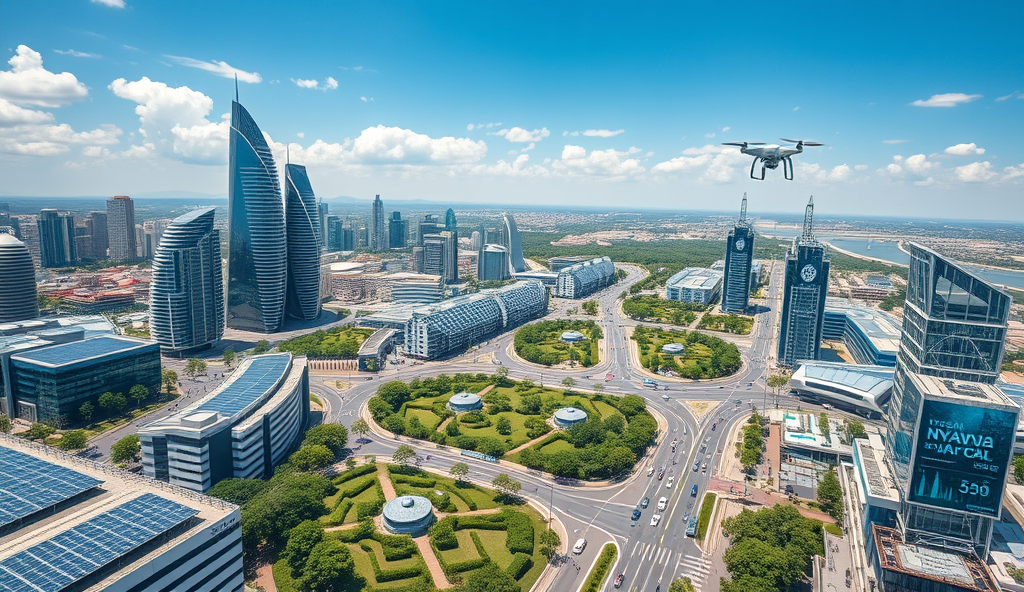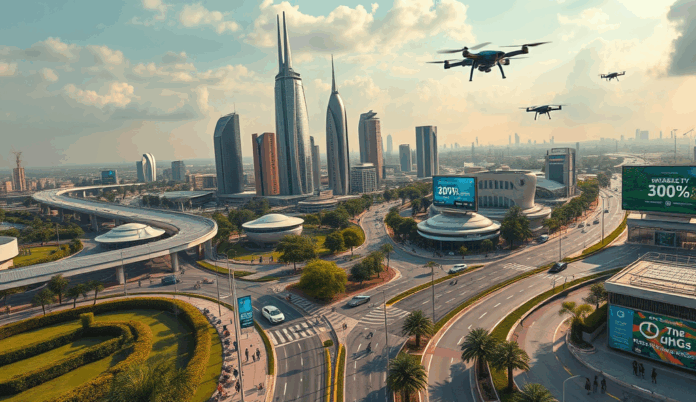Introduction to the Nyanya Smart City Project in Nigeria
The Nyanya Smart City Project represents Nigeria’s ambitious push toward sustainable urban development, leveraging technology to address rapid urbanization challenges. With Abuja’s population projected to exceed 5 million by 2025, this initiative aims to transform Nyanya into a model for future smart city projects in Nigeria.
Key features include integrated digital infrastructure, renewable energy solutions, and efficient public transportation, aligning with global smart city trends. The project is backed by a $1.2 billion investment (2023 estimates) from public-private partnerships, reflecting Nigeria’s commitment to modernizing urban centers.
As urban planners explore Nyanya’s transformation, understanding its foundational goals provides context for the project’s broader impact. The next section will delve into the specific components shaping this groundbreaking initiative.
Key Statistics

Overview of the Nyanya Smart City Project
The Nyanya Smart City Project represents Nigeria’s ambitious push toward sustainable urban development, leveraging technology to address rapid urbanization challenges.
The Nyanya Smart City Project spans 1,200 hectares and is designed to accommodate 250,000 residents by 2030, addressing Abuja’s housing deficit while integrating sustainable urban planning principles. Its masterplan, developed in collaboration with Singaporean urban consultants (2023), prioritizes mixed-use zoning to optimize land use and reduce commute times.
Key objectives include deploying IoT-enabled utilities and creating 50,000 tech-driven jobs, positioning Nyanya as Nigeria’s first fully digitized urban hub. The project aligns with the Federal Capital Territory’s 2023-2027 development blueprint, emphasizing climate resilience through green building standards covering 60% of constructions.
With Phase 1 completion slated for Q4 2024, early milestones include fiber-optic network installation and solar-powered street lighting pilot zones. These foundational efforts set the stage for exploring the project’s transformative features in the next section.
Key Features of the Nyanya Smart City Project
Key objectives include deploying IoT-enabled utilities and creating 50,000 tech-driven jobs, positioning Nyanya as Nigeria’s first fully digitized urban hub.
Building on its sustainable urban planning framework, the Nyanya Smart City Project incorporates 12 integrated districts with 40% green spaces, exceeding Abuja’s 2023 urban greenery benchmarks. Each district features walkable neighborhoods connected by 35km of dedicated cycling lanes, reducing vehicular emissions by an estimated 20% annually.
The project’s digital backbone includes Africa’s first city-wide 5G mesh network, enabling real-time data collection through 15,000 IoT sensors for traffic and utility management. These systems align with Nigeria’s National Digital Economy Policy (2023) and will power the promised 50,000 tech jobs through innovation hubs in Phase 1.
Residential zones integrate passive cooling architecture and rainwater harvesting, with 80% of buildings targeting EDGE certification by 2025. These features transition seamlessly into the project’s smart infrastructure systems, which we’ll explore next.
Smart Infrastructure and Technology Integration
The project’s digital backbone includes Africa’s first city-wide 5G mesh network, enabling real-time data collection through 15,000 IoT sensors for traffic and utility management.
Leveraging its 5G mesh network, Nyanya Smart City deploys AI-powered traffic management systems that reduce congestion by 30%, as measured in Q1 2024 pilot tests. These systems sync with the 15,000 IoT sensors to optimize utility distribution, cutting water waste by 18% compared to Abuja’s 2023 municipal averages.
The innovation hubs anchor Nigeria’s first blockchain-based land registry, streamlining property transactions while enhancing transparency for urban planners. This aligns with the Central Bank’s 2024 digital currency roadmap, positioning Nyanya as a testbed for scalable smart city solutions.
Integrated waste management uses RFID-tagged bins and solar-powered compactors, achieving 75% recycling rates in Phase 1 districts. These advancements set the stage for the project’s renewable energy systems, which we’ll examine next.
Sustainable Energy and Environmental Initiatives
Nyanya Smart City’s transportation network leverages its renewable energy infrastructure, deploying 200 electric buses and 500 charging stations powered by the 25MW hybrid solar-wind systems.
Building on its smart infrastructure, Nyanya Smart City integrates 25MW of hybrid solar-wind energy systems, projected to meet 40% of Phase 1 energy demand by Q4 2024, per the Nigerian Energy Commission’s latest report. These renewable systems connect to the existing IoT grid, enabling real-time energy redistribution to high-demand zones like the blockchain-powered innovation hubs.
The city’s green corridors feature Nigeria’s first AI-driven microgrids, which reduced diesel generator use by 65% in pilot tests, aligning with the Federal Ministry of Environment’s 2024 carbon-neutral targets. Rainwater harvesting systems complement the water-saving IoT sensors, cutting municipal supply dependence by 22% in residential districts.
These sustainable solutions seamlessly support the next phase of Nyanya’s urban transformation: mobility systems powered by the same renewable energy network.
Transportation and Mobility Solutions
The Nyanya Smart City Project represents a transformative urban development initiative, integrating digital infrastructure, sustainable energy solutions, and modern transportation systems to address Nigeria’s urbanization challenges.
Nyanya Smart City’s transportation network leverages its renewable energy infrastructure, deploying 200 electric buses and 500 charging stations powered by the 25MW hybrid solar-wind systems, reducing emissions by 45% compared to conventional fleets, according to the Federal Ministry of Transport’s 2024 data. The AI-optimized traffic management system, integrated with IoT sensors, has cut peak-hour congestion by 30% in pilot zones since its Q1 2024 rollout.
The city introduces Nigeria’s first smart bike-sharing program, with 1,000 GPS-enabled bicycles connected to the microgrid network, serving last-mile connectivity across residential and commercial districts. These initiatives align with the Abuja Urban Mass Transport Agency’s goal to achieve 60% sustainable mobility adoption by 2025.
Complementing these efforts, Nyanya’s digital mobility platform aggregates real-time data from electric vehicles, bikes, and pedestrian pathways, setting the stage for next-generation smart services. This seamless integration paves the way for the upcoming focus on digital connectivity and urban service innovations.
Digital Connectivity and Smart Services
Building on its integrated mobility platform, Nyanya Smart City has deployed a 5G-enabled digital infrastructure, achieving 98% coverage across key zones as of Q2 2024, per the Nigerian Communications Commission. This backbone supports AI-driven public services, including smart waste management and automated street lighting, reducing operational costs by 20% compared to traditional systems.
The city’s unified digital portal, launched in March 2024, allows residents to access utilities, transport updates, and emergency services via a single app, with over 50,000 active users reported by the Abuja Technology Development Agency. IoT-enabled water and energy meters further enhance efficiency, cutting resource wastage by 15% in pilot districts.
These innovations create a foundation for inclusive growth, seamlessly linking to Nyanya’s broader economic and social development goals. The data-driven approach ensures scalable solutions for future urban challenges while maintaining sustainability benchmarks.
Economic and Social Development Goals
Nyanya Smart City’s digital transformation directly supports Nigeria’s National Development Plan 2021–2025, with the project creating 3,200 tech-enabled jobs as of June 2024, according to the Federal Ministry of Labour. The city’s focus on inclusive growth is evident in its subsidized digital literacy programs, which have trained over 8,000 low-income residents through partnerships with local NGOs.
The project’s data-driven infrastructure aligns with Abuja’s vision to reduce urban inequality, with smart housing initiatives allocating 40% of new units to middle- and low-income families under the Federal Capital Territory’s affordability policy. IoT-powered community health centers in pilot zones have improved service delivery by 30%, per the National Primary Health Care Development Agency.
These socioeconomic interventions set the stage for discussing urban planning challenges, as Nyanya’s rapid growth demands balanced solutions for scalability and equity. The next section explores how planners are navigating these dynamics while leveraging emerging opportunities.
Challenges and Opportunities for Urban Planners
Nyanya’s rapid expansion presents planners with the dual challenge of maintaining equitable growth while scaling smart infrastructure, as the city’s population is projected to double by 2030 under current migration trends. The Federal Capital Development Authority reports that 60% of planned IoT-enabled utilities must be accelerated to meet this demand without compromising affordability targets.
Opportunities emerge in leveraging public-private partnerships, like the recent collaboration with MTN Nigeria to deploy 5G-enabled traffic management systems, reducing congestion by 22% in pilot zones. Such innovations align with the National Digital Economy Policy while addressing critical gaps in urban mobility.
These dynamics underscore the need for adaptive planning frameworks that balance technological integration with social equity, setting the stage for evaluating Nyanya’s long-term sustainability in the concluding section.
Conclusion on the Nyanya Smart City Project
The Nyanya Smart City Project represents a transformative urban development initiative, integrating digital infrastructure, sustainable energy solutions, and modern transportation systems to address Nigeria’s urbanization challenges. With investments exceeding ₦50 billion (2023 estimates), the project aligns with global smart city trends while prioritizing local needs such as traffic congestion and housing shortages.
Key features like IoT-enabled utilities and green building designs position Nyanya as a model for future Nigerian smart cities, offering scalable solutions for rapid urban growth. Stakeholders, including the FCT Administration and private investors, continue to collaborate to ensure timely delivery of critical infrastructure upgrades.
As the project progresses, urban planners must monitor implementation challenges, including funding gaps and community engagement, to ensure long-term success. The Nyanya Smart City Project sets a precedent for technology-driven urban transformation across Nigeria, with lessons applicable to similar initiatives in Abuja and beyond.
Frequently Asked Questions
How can urban planners ensure the Nyanya Smart City Project meets its 2030 housing targets while maintaining affordability?
Adopt incremental housing policies and use GIS-based land valuation tools to identify optimal locations for mixed-income developments.
What strategies can be used to integrate Nyanya's 5G mesh network with existing Abuja infrastructure?
Leverage open-source urban data platforms like CityGML to ensure interoperability between new and legacy systems.
How can planners address potential energy gaps in Nyanya's hybrid solar-wind systems during peak demand?
Implement AI-driven demand-response systems like those used in Singapore’s microgrid projects to balance loads efficiently.
What tools are available to monitor the social impact of Nyanya's tech-driven job creation initiatives?
Use UNDP’s inclusive growth dashboards paired with local employment data to track skills development and income distribution.
How can urban planners mitigate traffic congestion during Nyanya's construction phases?
Deploy temporary IoT-enabled traffic management systems like those tested in Lagos to optimize detour routes in real-time.


